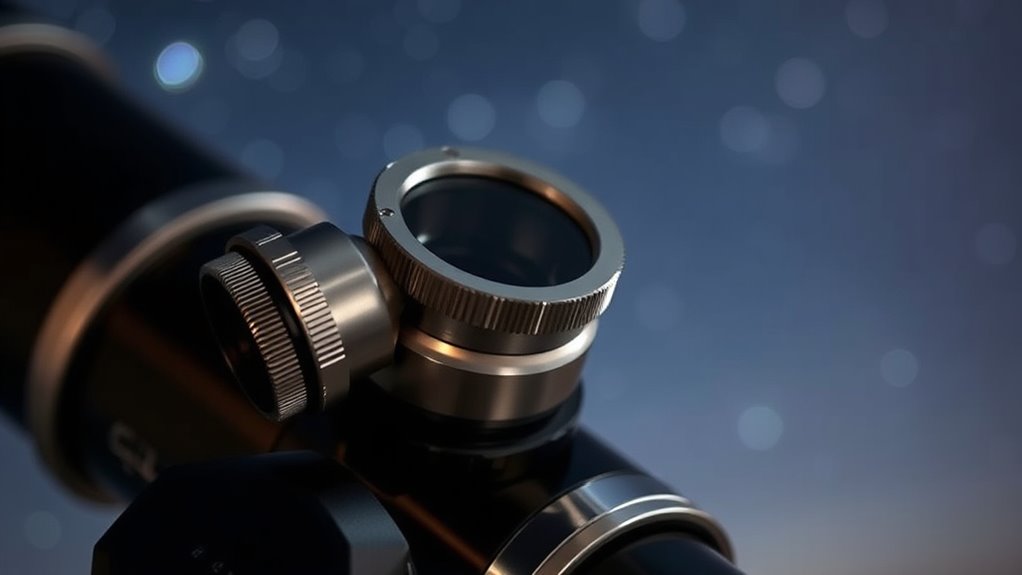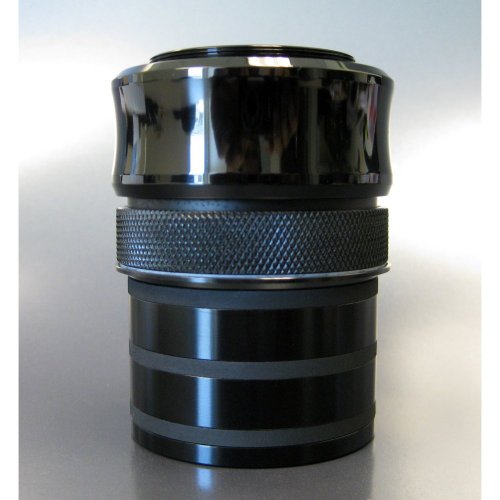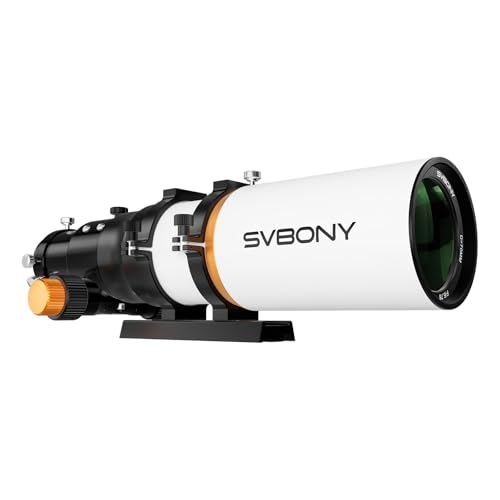If you’re looking to boost your astrophotography, choosing the right field flattener is key. I recommend considering options like the Sky-Watcher Evolux 62ED reducer/flattener, SVBONY SV193, SV209, and other top devices designed for refractors between f/4 and f/8. These tools help correct field curvature, reduce star distortion, and deliver sharp, edge-to-edge images. Keep in mind compatibility and proper spacing for best results—if you keep exploring, you’ll find more solutions that fit your setup perfectly.
Key Takeaways
- Select flatteners compatible with your telescope’s focal ratio (f/4 to f/8) for optimal field correction.
- Prioritize fully multi-coated optical elements to enhance contrast and minimize reflections in astrophotography.
- Ensure proper back focus distance (typically around 55mm) for precise focus and minimal star distortion.
- Choose lightweight, durable flatteners with secure threaded connections like M48x0.75 or T-ring compatibility.
- Consider models offering focal length adjustment to expand field coverage and improve wide-field imaging.
Sky-Watcher Evolux 62ED Reducer/Flattener (0.9X)
If you’re serious about astrophotography with your refractor telescope, the Sky-Watcher Evolux 62ED Reducer/Flattener (0.9X) is an excellent choice because it substantially improves image quality by flattening the field and reducing exposure times. Its 62mm aperture and f/5.8 focal ratio deliver sharp, detailed images with minimal chromatic aberration, thanks to the included ED element. Compatible with M56x1 female and M48 male threads, it fits a variety of setups. The compact, lightweight design makes it easy to carry, while the built-in filter cavity adds versatility. Overall, this reducer/flattener elevates your astrophotography results with precision and convenience.
Best For: Amateur and professional astrophotographers seeking to enhance image quality and reduce exposure times with their refractor telescopes.
Pros:
- Significantly flattens the field for sharper, more accurate astrophotography images.
- Includes an ED element to minimize chromatic aberration and improve clarity.
- Compact, lightweight, and easy to integrate into various setups with versatile threading options.
Cons:
- May require careful adjustment to achieve optimal focus and back focus distance.
- Compatibility limited to telescopes with M56x1 female or M48 male threads; not universal.
- Slightly higher cost compared to basic reducers or flattners without ED elements or filter cavities.
SVBONY SV503 Refractor Telescope with Built-in Field Flattener and SV305C Pro Telescope Camera
The SVBONY SV503 Refractor Telescope stands out as an excellent choice for amateur astronomers seeking high-quality imaging with minimal distortion, thanks to its built-in field flattener. This feature guarantees flat, wide views without edge blur or distortion, making it ideal for astrophotography. Its 70mm aperture and F/6.78 focal ratio deliver bright, sharp images of planets, galaxies, and nebulae. Paired with the SV305C Pro Camera, which boasts high sensitivity and low noise, it captures detailed planetary images even in low light. The combination of quality optics and advanced imaging capabilities makes this system perfect for both planetary observation and deep-sky astrophotography.
Best For: amateur astronomers and astrophotographers seeking high-quality planetary and deep-sky imaging with minimal distortion and vibrant, true-to-life colors.
Pros:
- Built-in field flattener ensures flat, wide views free from edge blur or distortion
- High-sensitivity IMX662 camera captures detailed images even in low-light conditions
- Combines high optical quality with low noise for sharp, bright, and accurate celestial images
Cons:
- May require additional accessories for advanced astrophotography setups
- Larger or more complex for complete beginners unfamiliar with telescope operation
- Limited aperture size might restrict very deep-sky object observation compared to larger telescopes
SVBONY SV193 Focal Reducer 2 Inch 0.8X Telescope Accessory
Astrophotographers seeking sharper, more detailed images will appreciate the SVBONY SV193 Focal Reducer’s ability to correct star distortions at the edges of their photos. This 2-inch accessory reduces focal length by 0.8x, shortening exposure times and improving efficiency. Its design supports full-frame cameras and 2-inch filters, making it versatile for various setups. The focal reducer is compatible with refractors like the SV503 80mm F7 ED, and its threaded M48 connection ensures easy integration. Overall, it’s an excellent tool for achieving crisp, professional-looking celestial images with minimal post-processing effort.
Best For: astrophotographers using refractor telescopes who want to improve image sharpness, reduce exposure times, and support full-frame cameras and 2-inch filters.
Pros:
- Corrects star distortions at the edges for sharper celestial images
- Shortens exposure times, increasing imaging efficiency
- Compatible with standard 2-inch filters and full-frame cameras for versatile use
Cons:
- Designed primarily for advanced refractor telescopes, may not suit all telescope types
- Requires proper threading and compatibility checks for specific camera setups
- Slightly adds to the optical train, which could potentially impact image brightness if not used carefully
SVBONY SV209 Field Flattener, 0.8X Focal Reducer for Refractor Telescopes
For those seeking sharper, wider images in astrophotography, the SVBONY SV209 Field Flattener stands out as an excellent choice. Designed specifically for the SV550 122mm f/7 APO refractor, it corrects field curvature and enhances edge-to-edge sharpness. By reducing the focal length from 854mm to 683.2mm, it also accelerates imaging and widens the field of view. The 63×1 metric threading ensures a secure fit into your focuser, making setup straightforward. Whether capturing star fields or terrestrial scenes, this flattener improves overall image quality, delivering consistent, crisp results across the entire sensor.
Best For: astrophotographers using SV550 122mm f/7 APO refractors seeking to improve image sharpness, widen their field of view, and reduce focal length for faster imaging.
Pros:
- Corrects field curvature for sharper, edge-to-edge images
- Widens field of view by reducing focal length to f/5.6
- Secure 63×1 metric threading for easy, stable attachment
Cons:
- Designed primarily for the SV550 telescope, limiting universal compatibility
- May require additional adapters for non-SVBONY telescopes
- Slightly increases complexity of setup for beginners
SVBONY Focal Reducer for SV503 102mm ED Telescope
If you’re aiming to capture wider, sharper celestial images with your SV503 102mm ED refractor, the SVBONY Focal Reducer is an excellent choice. It offers 0.8x focal reduction and field flattening, perfect for full-frame astrophotography. This reduces your focus length, improves the signal-to-noise ratio, and produces distortion-free images with edge-to-edge sharpness. Made with multi-coated optics, a lightweight aluminum body, and a durable finish, it’s built to last. Its compatibility with standard filters and various cameras makes it versatile. Overall, this focal reducer enhances your imaging quality, letting you capture stunning, detailed cosmic views effortlessly.
Best For: astrophotographers seeking wider, sharper, and distortion-free celestial images with their SV503 102mm ED telescope, especially those using full-frame sensors.
Pros:
- Provides 0.8x focal reduction for wider sky views and enhanced imaging.
- Produces edge-to-edge sharp, distortion-free images suitable for full-frame astrophotography.
- Constructed with durable, multi-coated optics and lightweight aluminum body for longevity and ease of use.
Cons:
- May require precise alignment to achieve optimal image quality.
- Compatibility limited to specific telescope models and camera setups without adapters.
- Slightly adds to the overall length and weight of the imaging train, requiring careful handling.
HOTECH SCA 2 Inch Field Flattener for Refractor Telescopes
The HOTECH SCA 2 Inch Field Flattener stands out as an excellent choice for amateur and professional astronomers seeking sharp, distortion-free images across the entire field of view. Designed for refractor telescopes with f-ratios between f5 and f8, it features a fully multi-coated two-element lens that maximizes light transmission and image brightness. Its built-in M48 filter thread and compatibility with all 35mm T-rings simplify setup. The center-loading T-adapter with a compression ring guarantees proper camera alignment, making it easy to achieve precise focus. Rated 4.4 stars, it’s a reliable tool that enhances astrophotography quality across a variety of setups.
Best For: amateur and professional astronomers seeking high-quality, distortion-free astrophotography with refractor telescopes in f-ratios between f5 and f8.
Pros:
- Fully multi-coated two-element lens ensures maximum light transmission and sharp images.
- Built-in M48 filter thread and compatibility with all 35mm T-rings simplify setup and versatility.
- Center-loading T-adapter with compression ring guarantees precise camera alignment and focus.
Cons:
- Compatible only with refractor telescopes in the f5 to f8 range, limiting use with other types.
- May require careful adjustment to achieve optimal focus and alignment.
- Slightly higher price point compared to simpler flattener models, which could be a consideration for budget-conscious users.
SVBONY SV503 Refractor Telescope with Built-in Field Flattener
Looking for a refractor telescope that delivers sharp, distortion-free images right out of the box? The SVBONY SV503 with its built-in field flattener offers outstanding flat-field correction, eliminating edge blur and distortion. Its 70mm aperture at F/6.78 captures bright, detailed images of galaxies and nebulae, while ED glass reduces chromatic aberration for true-to-life colors. The self-flat-field design means no need for extra accessories—just focus and start imaging. Its durable CNC aluminum construction and stable mount ensure steady views. Perfect for astrophotographers seeking crisp, color-accurate images with minimal setup, the SV503 simplifies high-quality astrophotography.
Best For: amateur and intermediate astronomers seeking high-quality, flat-field astrophotography with minimal setup and distortion.
Pros:
- Outstanding flat-field correction with built-in field flattener eliminates edge blur and distortion
- Bright, sharp images with minimal chromatic aberration thanks to ED glass optics
- Durable CNC aluminum construction and stable mount ensure steady, vibration-free viewing
Cons:
- Limited aperture size of 70mm may not gather as much light as larger telescopes for deep-sky imaging
- F/6.78 focal ratio might require longer exposures for certain astrophotography applications
- Designed primarily for adults, so may not be suitable for beginner or children’s use
SVBONY SV503 Refractor Telescope, 102mm F7 Achromatic Refractor
For amateur astronomers seeking sharp, detailed images with minimal chromatic aberration, the SVBONY SV503 Refractor Telescope offers an excellent choice. Its 102mm aperture and F7 focal ratio deliver bright, high-contrast images suitable for deep sky and planetary viewing. The achromatic doublet lens made from S-FPL51 glass reduces chromatic aberration, ensuring natural colors and sharp details. Fully multi-coated optics maximize light transmission, enhancing image brightness and contrast. The dual-speed focuser and 360° field rotator make precise focusing and framing effortless. Plus, the retractable lens hood protects your optics from stray light and dust, making it versatile and reliable for astrophotography.
Best For: amateur astronomers and astrophotographers seeking high-quality, detailed images with minimal chromatic aberration.
Pros:
- High-quality 102mm aperture with F7 focal ratio provides bright, detailed images suitable for deep sky and planetary viewing
- Achromatic doublet lens made from S-FPL51 glass effectively reduces chromatic aberration for natural colors and sharp details
- Fully multi-coated optics maximize light transmission, enhancing brightness, contrast, and image clarity
Cons:
- May be heavier and bulkier compared to smaller, more portable telescopes
- Requires steady mount and proper alignment for optimal performance
- Not ideal for very wide-field viewing due to its design focused on high magnification
SVBONY SV220 Dual-Band Nebula Filter with SV503 70mm Refractor Telescope
If you’re seeking to enhance your nebula observations and astrophotography, the SVBONY SV220 Dual-Band Nebula Filter paired with the SV503 70mm Refractor Telescope offers a compelling solution. The SV503’s 70mm aperture and built-in field flattener deliver sharp, bright images with minimal distortion, even at the edges. The dual-band nebula filter reduces light pollution and enhances contrast, making gaseous nebulae stand out clearly under various sky conditions. Together, they provide high-contrast, detailed views of deep-sky objects, whether you’re observing visually or capturing images. This setup is ideal for amateurs who want improved nebula imaging in light-polluted environments.
Best For: amateur astronomers and astrophotographers seeking to enhance nebula observation and imaging in light-polluted environments with a compact, high-quality telescope setup.
Pros:
- Provides sharp, bright, and detailed images of nebulae with minimal distortion thanks to built-in field flattener.
- Effectively reduces light pollution and enhances contrast, making gaseous nebulae stand out clearly under various sky conditions.
- Suitable for both visual observation and astrophotography, offering high-contrast, high-quality celestial images.
Cons:
- Limited aperture size (70mm) may restrict deep-sky object brightness compared to larger telescopes.
- The dual-band nebula filter is specialized, potentially less effective for objects outside nebulae or in very dark skies.
- Requires proper handling and cleaning to maintain optical performance and filter effectiveness over time.
SVBONY SV260 2″ Telescope Filter with SV503 Refractor Telescope
The SVBONY SV260 2″ Telescope Filter paired with the SV503 Refractor Telescope is an excellent choice for astrophotographers seeking to reduce light pollution and enhance image clarity. Its multi-bandpass design effectively blocks unwanted light, allowing over 90% transmittance of targeted wavelengths, which results in brighter, sharper images of galaxies, nebulae, and star clusters. The filter’s OD4 cut-off depth guarantees strong light pollution suppression, while true color restoration adds richer hues to your photos. Combined with the SV503’s flat-field correction and built-in field flattener, this setup provides distortion-free, wide-field views—perfect for capturing detailed, vibrant deep-sky images.
Best For: Amateur and professional astrophotographers seeking to improve deep-sky imaging quality by reducing light pollution and capturing vibrant, true-to-life celestial images.
Pros:
- High transmittance over 90% ensures bright, clear images of galaxies, nebulae, and star clusters.
- Effective light pollution suppression with OD4 cut-off depth enhances image contrast.
- Flat-field correction and built-in field flattener provide distortion-free, wide-field views for detailed astrophotography.
Cons:
- May require precise alignment and handling due to its optical complexity.
- Compatibility limited to 2″ telescope accessories; may need adapters for other systems.
- The filter’s cost might be higher compared to basic light pollution filters, reflecting its advanced features.
Explore Scientific Field Flattener for Refractor Telescopes
Astrophotographers aiming to capture sharp, distortion-free images will appreciate the Explore Scientific Field Flattener, designed specifically for refractor telescopes with focal ratios between f/5 and f/7. Its main purpose is to minimize star distortion caused by field curvature, ensuring stars stay sharp across the entire image. The flattener attaches easily between the telescope and camera, using a T-ring thread for secure connection. Fully multi-coated optics maximize light transmission, delivering high-contrast images suitable for planets, nebulae, galaxies, and star clusters. With proper spacing of about 55mm, this device enhances your astrophotography, supported by reliable customer service from Explore Scientific based in Arkansas.
Best For: astrophotographers using refractor telescopes with focal ratios between f/5 and f/7 seeking to improve image sharpness and reduce star distortion across their astrophotography field.
Pros:
- Effectively minimizes star distortion caused by field curvature.
- Fully multi-coated optics maximize light transmission for high-contrast, detailed images.
- Easy to connect with telescopes and cameras using T-ring threads, ensuring secure attachment.
Cons:
- Requires precise spacing of approximately 55mm for optimal performance, which may need careful adjustment.
- Designed specifically for refractors with certain focal ratios, limiting versatility with other telescope types.
- Additional accessories like T-rings are necessary for camera attachment, potentially increasing setup complexity.
Astromania 2″ Field Flattener for Astronomy Photos
Designed to deliver perfectly flat images across the entire field, the Astromania 2″ Field Flattener is ideal for astrophotographers using refractor telescopes from f/4 to f/8. It features M48 threading for full aperture illumination and offers -109mm back focus, providing flexibility for accessories. This flattener effectively corrects field curvature, resulting in pin-sharp stars from center to edge. Its multi-coated lenses minimize reflections and boost image brightness and clarity. Weighing just 8.8 ounces, it’s lightweight and portable, making it easy to use during long imaging sessions. Overall, it’s a reliable tool to produce distortion-free, professional-quality astrophotos.
Best For: astrophotographers using refractor telescopes from f/4 to f/8 who want sharp, distortion-free images with full aperture illumination.
Pros:
- Produces pin-sharp stars across the entire image field, ensuring high-quality astrophotos
- Fully compatible with telescopes from f/4 to f/8 using M48 threading and offers flexible back focus
- Multi-coated lenses reduce reflections and increase image brightness and clarity
Cons:
- Weighs only 8.8 ounces, which might be too lightweight for some heavier setups requiring additional stabilization
- Designed specifically for refractors within a certain focal ratio range, limiting broader telescope compatibility
- Requires proper attachment and alignment to achieve optimal flatness, which may involve a learning curve for beginners
SVBONY SV503 Portable Telescope Tube, 70ED F6 Extra Low Dispersion Optical Tube
If you’re looking for a portable, high-quality optical tube that minimizes chromatic aberration, the SVBONY SV503 70ED F6 Extra Low Dispersion Tube is an excellent choice. It features S-FPL51 ED glass and a doublet air-spaced achromatic lens, delivering sharp, high-contrast images perfect for astrophotography and terrestrial viewing. The 2-inch rack-and-pinion focuser supports heavy photographic accessories, making it versatile for capturing moon, nebulae, galaxies, or nature scenes. Its lightweight design (under 5 pounds) and compact dimensions make it ideal for travel. Whether you’re a beginner or experienced astronomer, this tube provides authentic, detailed visuals with reduced chromatic aberration.
Best For: amateur astronomers and mobile observers seeking a portable, high-quality optical tube with minimal chromatic aberration for astrophotography and terrestrial viewing.
Pros:
- Features S-FPL51 ED glass and doublet air-spaced achromatic lens for sharp, high-contrast images
- Supports heavy photographic accessories with a durable 2-inch rack-and-pinion focuser
- Lightweight (under 5 pounds) and compact, making it highly portable for travel and mobile astronomy
Cons:
- Limited to a 70mm aperture, which may be less suitable for deep-sky astrophotography compared to larger scopes
- May require additional accessories (e.g., mount, tripod) for optimal use
- As a portable optical tube, it might be less stable than larger, fixed telescopes for prolonged observations
Astromania 2″ Field Flattener for Astronomy Photos
The Astromania 2″ Field Flattener is an excellent choice for anyone looking to achieve perfectly flat, sharp images across their refractor telescope’s entire field of view. It’s designed for telescopes with f/4 to f/8 and features M48 threading, supporting full aperture illumination at 2 inches back focus. This flattener effectively corrects field curvature, ensuring pin-sharp stars from edge to edge, which is vital for high-quality astrophotography. Its multi-coated lens maximizes light transmission and image clarity. Compact and lightweight, it’s easy to use and compatible with a wide range of refractors, making it a reliable tool to elevate your astrophotography results.
Best For: amateur and professional astrophotographers seeking to achieve perfectly flat, sharp images across their refractor telescope’s entire field of view.
Pros:
- Corrects field curvature for edge-to-edge sharpness in astrophotos
- Fully compatible with telescopes f/4 to f/8 and M48 threading
- Multi-coated lens maximizes light transmission and image clarity
Cons:
- Only suitable for refractor telescopes within specified focal ratios
- Slightly limited to 2-inch back focus setups, may require adapters for other configurations
- Customer reviews indicate mixed satisfaction, with a rating of 3.8 out of 5 stars
SVBONY SV193 Focal Reducer 2 Inch 0.8X for Telescope Camera
Looking to expand your telescope’s field of view while ensuring sharp, distortion-free images? The SVBONY SV193 2-inch 0.8x focal reducer and field flattener is a great addition for refractor astrophotography. It connects easily via a standard 2-inch front socket and attaches to your camera with an M48x0.75 threaded end, supporting full-frame sensors like the IMX662. By reducing focal length by 0.8x, it broadens your view and flattens the field, minimizing star distortion at the edges. Perfect for capturing detailed planetary and deep-sky images, this reducer helps deliver clearer, more professional-quality astrophotos.
Best For: astrophotographers seeking to expand their telescope’s field of view with minimal distortion, especially those capturing planetary and deep-sky images using full-frame cameras.
Pros:
- Expands the field of view and flattens the field for sharper images across the frame
- Compatible with standard 2-inch accessories and supports full-frame sensors like IMX662
- Reduces focal length by 0.8x, enhancing celestial imaging capabilities
Cons:
- May require precise mounting to avoid vignetting or misalignment
- Compatibility limited to refractor telescopes with suitable connectors
- Potential slight reduction in brightness due to focal reduction effect
Factors to Consider When Choosing Field Flatteners for Refractor Telescopes

When selecting a field flattener, I focus on compatibility with my telescope’s focal ratio and the quality of its optical coatings to guarantee clear images. I also consider the focal length adjustment range and the connection types to match my setup easily. Finally, I check if it covers my desired field of view for maximum performance.
Compatibility With Telescope F-Ratio
Choosing a field flattener that matches your refractor’s focal ratio is essential for achieving sharp, distortion-free images across the entire field. If the flattener isn’t designed for your telescope’s f/ratio range—typically f/4 to f/8—you may face residual field curvature or image distortion at the edges. Always check the manufacturer’s specifications to confirm compatibility with your specific focal ratio. Some flatteners are adjustable or have recommended spacing that must be matched precisely to your telescope’s focal ratio for ideal correction. Using an incompatible flattener can cause vignetting, uneven illumination, or reduced sharpness. Ensuring the flattener supports your telescope’s focal ratio guarantees proper flat-field correction and helps you capture consistently clear, well-corrected astrophotos.
Optical Coatings Quality
Optical coatings play a vital role in guaranteeing the best image quality from your field flattener. High-quality coatings maximize light transmission, resulting in brighter, sharper images across the entire field of view. Fully multi-coated lenses reduce reflections and glare, boosting contrast and color accuracy—key factors for astrophotography. Multi-coated surfaces also minimize light loss, helping to preserve brightness even when using filters or narrowband imaging. Additionally, superior coatings protect lens surfaces from dust, moisture, and scratches, maintaining peak performance over time. The quality of these coatings directly impacts how effectively your field flattener reduces chromatic aberration and field curvature. Investing in well-coated optics ensures you get the clearest, most detailed images, making your astrophotography sessions more successful and enjoyable.
Focal Length Adjustment Range
Have you ever considered how the focal length adjustment range of a field flattener influences your astrophotography results? This range determines how much the flattener can modify your telescope’s effective focal length, affecting image scale and field of view. Most models offer a range from about 0.8x to 1.0x, with some providing specific reduction factors like 0.8x. Matching this adjustment range to your telescope’s original focal length is vital for best correction of field curvature without introducing aberrations. A larger adjustment, such as 0.8x, allows for a wider field of view—ideal for deep-sky imaging. Ensuring compatibility with your camera’s sensor size and desired framing helps achieve sharp, edge-to-edge focus across your entire image, enhancing overall image quality.
Threading and Connection Types
When selecting a field flattener, paying attention to threading and connection types is essential for ensuring a secure and proper fit with your refractor telescope and camera. Most flatteners feature standardized threading sizes like M48x0.75 or M54x1, which promote compatibility across different models. Connection types often include T-ring threads for attaching cameras and specific front socket sizes, such as 2-inch or 1.25-inch, for accessories. Proper threading guarantees stable, wobble-free connections that keep the optical alignment intact during imaging. Many flatteners also use multi-coated threads to reduce reflections and improve image quality. Ensuring that threading sizes and connection types match your equipment prevents issues like vignetting, star distortions, or potential damage to your optical components, making setup more reliable.
Field of View Coverage
Choosing the right field flattener means paying close attention to how much of the sky it can capture sharply across your camera’s sensor. The field of view coverage determines how much of the celestial object or sky area appears in focus from edge to edge. Most flatteners are designed for a specific field diameter, measured in millimeters or inches, guaranteeing a flat, distortion-free image within that range. It’s essential to match the flattener’s coverage with your camera’s sensor size; larger sensors, like full-frame DSLRs, need wider coverage to avoid vignetting or edge distortions. Compatibility with your refractor’s optical design also maximizes sharpness across the entire field, reducing the need for cropping or extensive post-processing. Proper coverage guarantees your astrophotography captures expansive, sharp images.
Ease of Installation
Selecting a field flattener that’s easy to install can considerably streamline your astrophotography setup. I recommend choosing one with compatible threading, like M48 or M54, to ensure straightforward attachment to your refractor. Look for models that include a built-in T-ring or simple adapters, which make connecting your camera quick and hassle-free. Opt for a device with minimal back focus requirements—this reduces the need for spacers or extension tubes, saving time and effort. Additionally, fully multi-coated optical elements not only protect the optics but also make cleaning easier. Finally, pick a design that’s compact and lightweight. This makes handling and setup much more manageable, helping you get started quickly and focus on capturing stunning astrophotos without unnecessary complications.
Light Transmission Efficiency
Maximizing light transmission efficiency in a field flattener is essential for capturing bright, contrast-rich images. High efficiency means minimal loss of brightness and detail, which is critical for astrophotography. Multi-coated optics play a key role, as they maximize light throughput and reduce reflections that can diminish image quality. A well-designed flattener with optimized optical coatings ensures more light reaches your camera, resulting in brighter, clearer images by minimizing absorption and scattering. Additionally, the optical elements’ design impacts how effectively light is transmitted across the entire field of view, especially at the edges. Good light transmission efficiency enables shorter exposures and captures more detail, making it a fundamental factor when selecting a field flattener for your refractor telescope.
Price and Brand Reputation
When evaluating field flatteners for your refractor telescope, considering the price and brand reputation can safeguard you from future headaches. Reputable brands generally uphold higher quality standards and offer better customer support, which ensures reliability and satisfaction. These brands often invest in advanced optical coatings and precise manufacturing, leading to more effective correction of field curvature. While premium brands tend to be more expensive, their products are usually more durable and optimized for performance. Brand reputation can also help guarantee compatibility with various refractor models, reducing installation issues or subpar results. Additionally, customer reviews from trusted brands offer valuable insights into long-term performance and ease of use. Balancing cost with brand reliability can ultimately lead to a more satisfying astrophotography experience.
Frequently Asked Questions
How Does a Field Flattener Affect Image Contrast and Color Correction?
A field flattener enhances image contrast by reducing optical distortions, ensuring stars stay sharp across the entire frame. It also improves color correction by minimizing chromatic aberration, which can cause color fringing around stars. I’ve noticed that using a good flattener results in clearer, more vibrant images with accurate colors from edge to center. Overall, it markedly boosts the quality of my astrophotography by delivering crisper, more true-to-life results.
Can Field Flatteners Be Used With Astrophotography Cameras Other Than DSLR?
Yes, field flatteners can be used with astrophotography cameras beyond DSLRs, including dedicated astronomy cameras like CCDs and CMOS sensors. I’ve used mine with both monochrome and color cameras, and they work great to produce flat, sharp images across the field. Just make sure your flattener is compatible with your specific camera’s size and connection type, and you’ll see improved image quality regardless of your camera choice.
What Is the Typical Lifespan of a Field Flattener With Proper Maintenance?
A well-maintained field flattener can last around 5 to 10 years, sometimes longer if you handle it carefully. I make sure to keep it clean, store it properly, and avoid any impacts or harsh conditions. Regularly inspecting the optics also helps catch any issues early. With proper care, your flattener will serve you well, maintaining peak performance and sharp images for many seasons.
Are There Compatibility Issues Between Different Brands of Refractors and Flatteners?
Compatibility can be tricky, and I’ve definitely run into issues between different brands of refractors and flatteners. I always check the mounting threads, optical distances, and back focus requirements before purchasing. It’s vital to verify compatibility, read reviews, and consult manufacturer specifications. Using adapters or custom spacers often helps, but I recommend sticking to recommended combinations whenever possible to guarantee proper performance and avoid frustrating mismatches.
How Do Temperature Changes Impact the Performance of a Field Flattener?
Temperature changes can greatly affect a field flattener’s performance. When it gets colder or warmer, materials expand or contract, which may cause slight misalignments or focus shifts. I’ve noticed that in extreme temperatures, images can become soft or distorted if the flattener isn’t designed to compensate for thermal variations. To minimize this, I always allow my equipment to acclimate and consider using temperature-compensating accessories.
Conclusion
Did you know that using the right field flattener can reduce image distortion by up to 90%? Choosing the best one for your refractor telescope can truly elevate your astrophotography game. Whether you’re aiming for crisp star fields or detailed deep-sky images, a quality flattener makes all the difference. So, invest wisely, and watch your images become sharper and more stunning—your night sky adventures will never be the same!

























